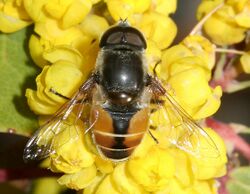Biology:Eristalis bellardii
From HandWiki
Short description: Species of fly
| Eristalis bellardii | |
|---|---|

| |
| Male | |
| Scientific classification | |
| Domain: | Eukaryota |
| Kingdom: | Animalia |
| Phylum: | Arthropoda |
| Class: | Insecta |
| Order: | Diptera |
| Family: | Syrphidae |
| Genus: | Eristalis |
| Species: | E. bellardii
|
| Binomial name | |
| Eristalis bellardii Jaennicke, 1867
| |
Eristalis bellardii, the Mexican Mountain Drone Fly, is an uncommon species of syrphid fly first officially described by Jaennicke in 1867. It is infrequently found in the Southwestern United States, Mexico and Central America. In appearance it is somewhat like that of a honeybee. [1] Hoverflies get their names from the ability to remain nearly motionless while in flight. The adults are also known as flower flies for they are commonly found around and on flowers, from which they get both energy-giving nectar and protein-rich pollen.[2][3][4]
Description
External images
For terms see Morphology of Diptera
- Head
- Black with face sometimes reddish brown laterally covered with yellowish- white pollen except for the shiny central stripe extend nearly to the antennae.: The gena is shiny with pale yellow pile. The frontal lunule is reddish brown. Antenna with a bare arista. The pile of the eye is brownish yellow but white ventrally. Male eyes touch along center while female eyes are separate.
- Thorax
- Black with yellow pile except the central part of the scutellum which has black pile over a reddish-brown base.
- Wings
- Hyaline with a yellow pilose tegula.
- Abdomen
- First tergum black, second tergum dull, orange on lateral 2/3, black on medial 1/3. Third tergum similar to second tergum in the male but the female orange on lateral is only about 1/3 the width. Fourth tergum in male orange on lateral 1/3 but in female entirely black.
- Genitalia
- Figure #9 in [=https://www.biodiversitylibrary.org/item/54855#page/228/mode/1up]
- Larvae
- Unknown [5]
References
- ↑ Jaennicke, F. (1867). "Neue exotische Dipteren". Abhandlungen der Senckenbergischen Naturforschenden Gesellschaft 6: 311-408. https://www.biodiversitylibrary.org/page/26186732#page/329/mode/1up.
- ↑ "Eristalis bellardii Report". https://www.itis.gov/servlet/SingleRpt/SingleRpt?search_topic=TSN&search_value=140921. Retrieved 2019-09-23.
- ↑ "Eristalis bellardii". https://www.gbif.org/species/1541128. Retrieved 2019-09-23.
- ↑ "Eristalis bellardii species Information". https://bugguide.net/node/view/739503. Retrieved 2019-09-23.
- ↑ THOMPSON, F. CHRISTIAN (1997). "Revision Of The Eristalis Flower Flies (Diptera: Syrphidae) Of The Americas South Of The United States". Entomological Society of Washington. https://www.biodiversitylibrary.org/item/54855#page/230/mode/1up.
Further reading
- Telford, H. S. (1970). "Eristalis (Diptera: Syrphidae) from America North of Mexico". Annals of the Entomological Society of America 63 (5): 1201–1210. doi:10.1093/aesa/63.5.1201.
Wikidata ☰ Q13612696 entry

